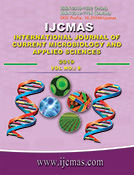


 National Academy of Agricultural Sciences (NAAS)
National Academy of Agricultural Sciences (NAAS)

|
PRINT ISSN : 2319-7692
Online ISSN : 2319-7706 Issues : 12 per year Publisher : Excellent Publishers Email : editorijcmas@gmail.com / submit@ijcmas.com Editor-in-chief: Dr.M.Prakash Index Copernicus ICV 2018: 95.39 NAAS RATING 2020: 5.38 |
The data correlated regarding the effect of atmospheric temperature, relative humidity and rainfall on disease development during 2002-03 and 2003-04 revealed that, moderate relative humidity accompanied by nearly moderate temperature favoured disease development in both the years. The maximum disease development was recorded in the second fortnight of November during both the years. The average maximum and minimum temperatures and relative humidities were 29.7ºC, 13.6ºC and 87.5, 39.2 per cent, respectively during 2002-03, whereas during 2003-04 average maximum and minimum temperature were 34.0ºC and 15.4 ºC, respectively with average maximum and minimum relative humidities of 73.3 and 45.2 per cent, which led to maximum disease development. The rainfall in January led to rise in relative humidity and fall in atmospheric temperature hampered the disease development.
 |
 |
 |
 |
 |